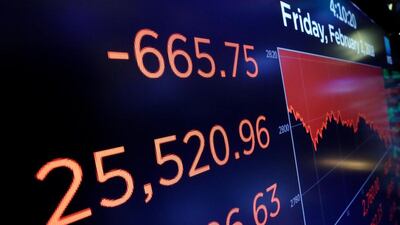Wall Street’s most widely followed gauge of future stock market volatility is being manipulated, a law firm representing an “anonymous whistleblower” alleged in a letter to regulators and seen by Reuters on Tuesday.
The accusations prompted Cboe Global Markets, the financial exchange operator that is home to the Cboe Volatility Index (VIX), to ask Wall Street's self-funded regulator, the Financial Industry Regulatory Authority (FINRA), to look into the matter.
“Cboe has a dedicated regulatory department that works with FINRA to monitor certain trading activity for our securities markets, including trading activity that could impact the VIX settlement,” Greg Hoogasian, Cboe’s chief regulatory officer, told Reuters in a statement.
The letter to the Securities and Exchange Commission (SEC) and the Commodity Futures Trading Commission (CFTC) from Zuckerman Law, a Washington-based firm, said it had been written on behalf of a person, not identified, who had held senior roles in the investment sector.
In addition to the letter, the law firm said it had filed a formal complaint with regulators on behalf of the unidentified client. It was not clear from the letter and a redacted copy of the complaint seen by Reuters what evidence the person might have provided to support claims of manipulation.
The complaint says regulators should look at trading data for proof of alleged manipulation.
The letter, dated Monday, alleged that trading firms had taken advantage of the way the VIX is calculated in order to manipulate the index, costing investors nearly $2 billion a year.
Financial products that seek to track the VIX are at the centre of recent stock market turbulence.
The VIX estimates the expected near-term volatility conveyed by S&P 500 index option prices. Cboe calculates an official settlement monthly that determines whether large blocks of VIX futures expire worthless or turn a profit.
The whistleblower’s letter alleges a flaw in the calculation of the VIX that allows trading firms to manipulate the VIX index by posting quotes for S&P 500 options, without actually trading.
Cboe spokeswoman Suzanne Cosgrove said in a statement: “This letter is replete with inaccurate statements, misconceptions and factual errors, including a fundamental misunderstanding of the relationship between the VIX Index, VIX futures and volatility exchange traded products, among other things.”
The SEC and CFTC declined to comment.
William Speth, Vice President and Cboe's head of research, said: “There are structural safeguards built into the process of the calculation of the VIX settlement value that would hinder the type of manipulation the letter alleges.”
“Our regulatory group actively [searches] for potential VIX settlement manipulation,” he said.
Last year John Griffin and Amin Shams of the McCombs School of Business at the University of Texas, Austin wrote a paper noting significant spikes in trading volume in S&P 500 index options at the exact time of the monthly VIX settlement.
The complaint alleging manipulation referenced the paper.
“It’s exactly what we talked about in our paper,” Mr Griffin told Reuters. "I would think the Cboe would want to redesign the settlement process to make it fairer and more transparent."
Cboe disagreed with the paper’s conclusions when it was posted on a website for research and said the jump in activity around settlement was due to investors adjusting their positions around contract expirations.
Cboe’s Speth said that traders posting quotes on SPX options have to keep them open for 10 minutes and could be forced to complete the trade.
“And in a world where microseconds count, that’s an eternity,” he said.
Stuart John Barton, portfolio manager at Invest In Vol, a volatility-focused registered investment advisor in Stamford, Connecticut, said: “There has been a longstanding understanding that there is a potential for the manipulation of the index level.”
Mr Barton said that losses to investors from such manipulations are probably much smaller than the nearly $2 billion annually alleged in the letter.
The letter alleged that manipulation of the volatility index also played a role in last week's market turmoil where VIX-related exchange-traded products (ETP) experienced big price swings.
Both Mr Barton and Mr Griffon cautioned that it was unlikely the type of manipulation alleged in the letter could have caused such a large spike in VIX futures.
“It would be scaremongering to say that it had a big impact on the reason why these products blew up,” Mr Barton said.

